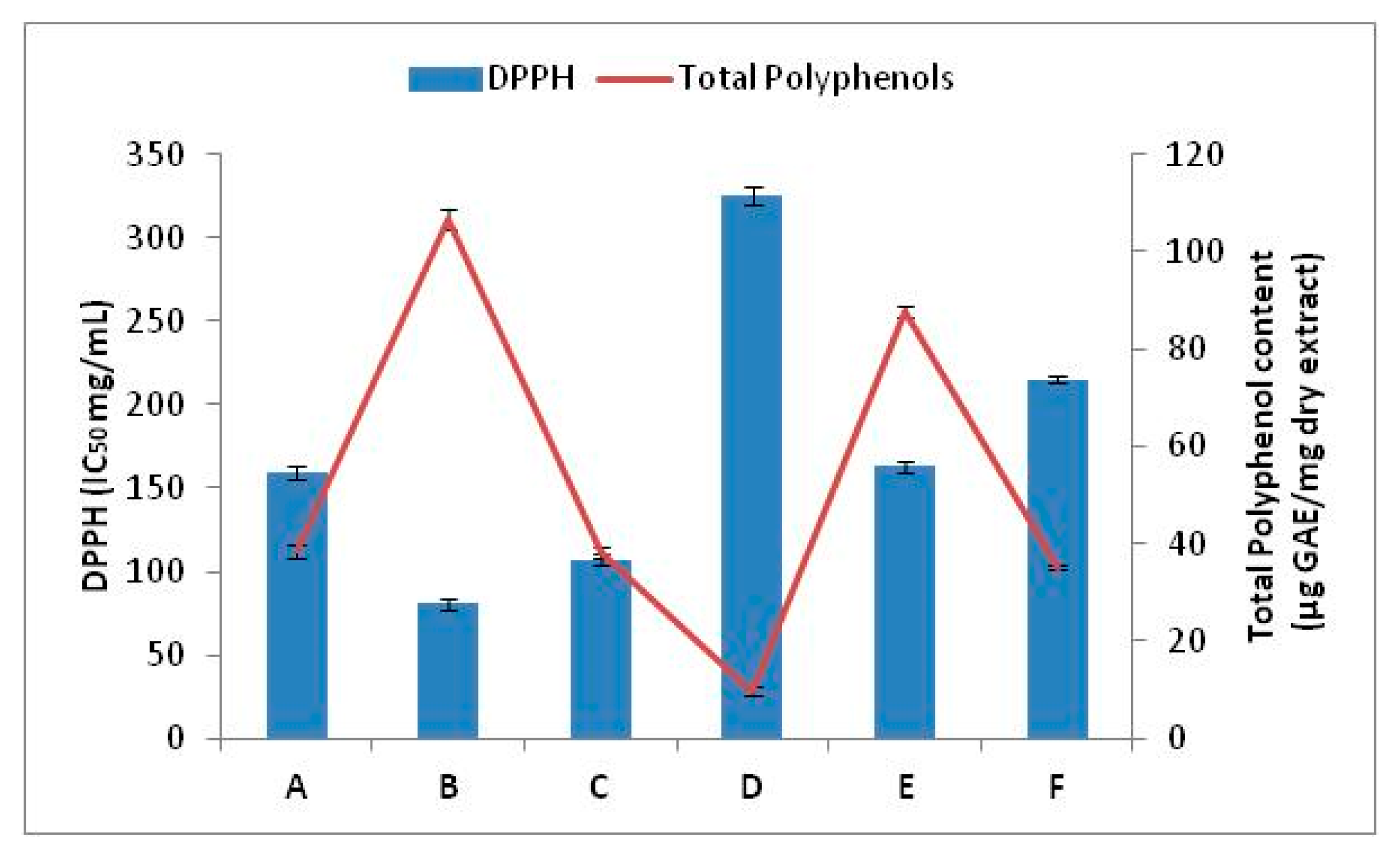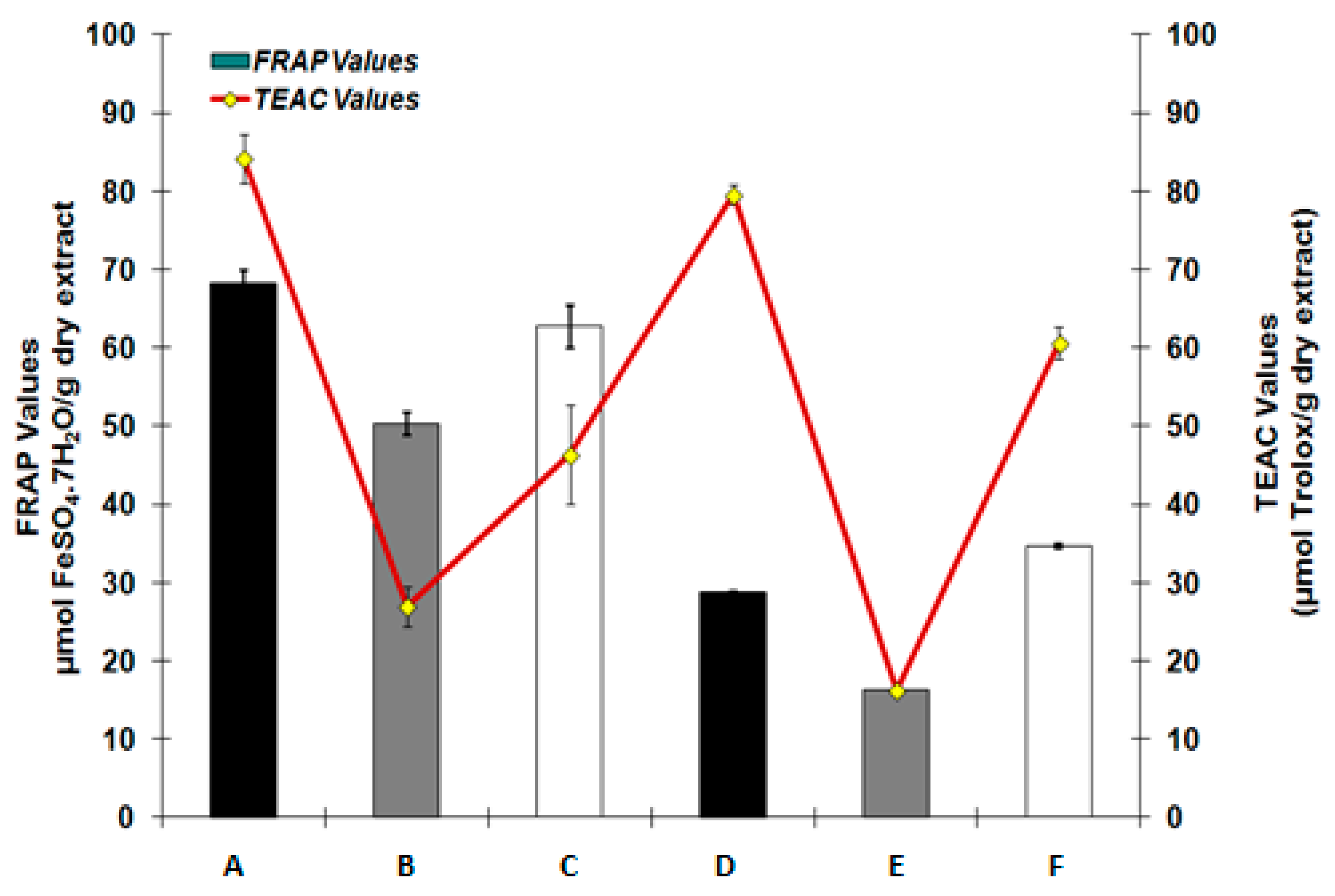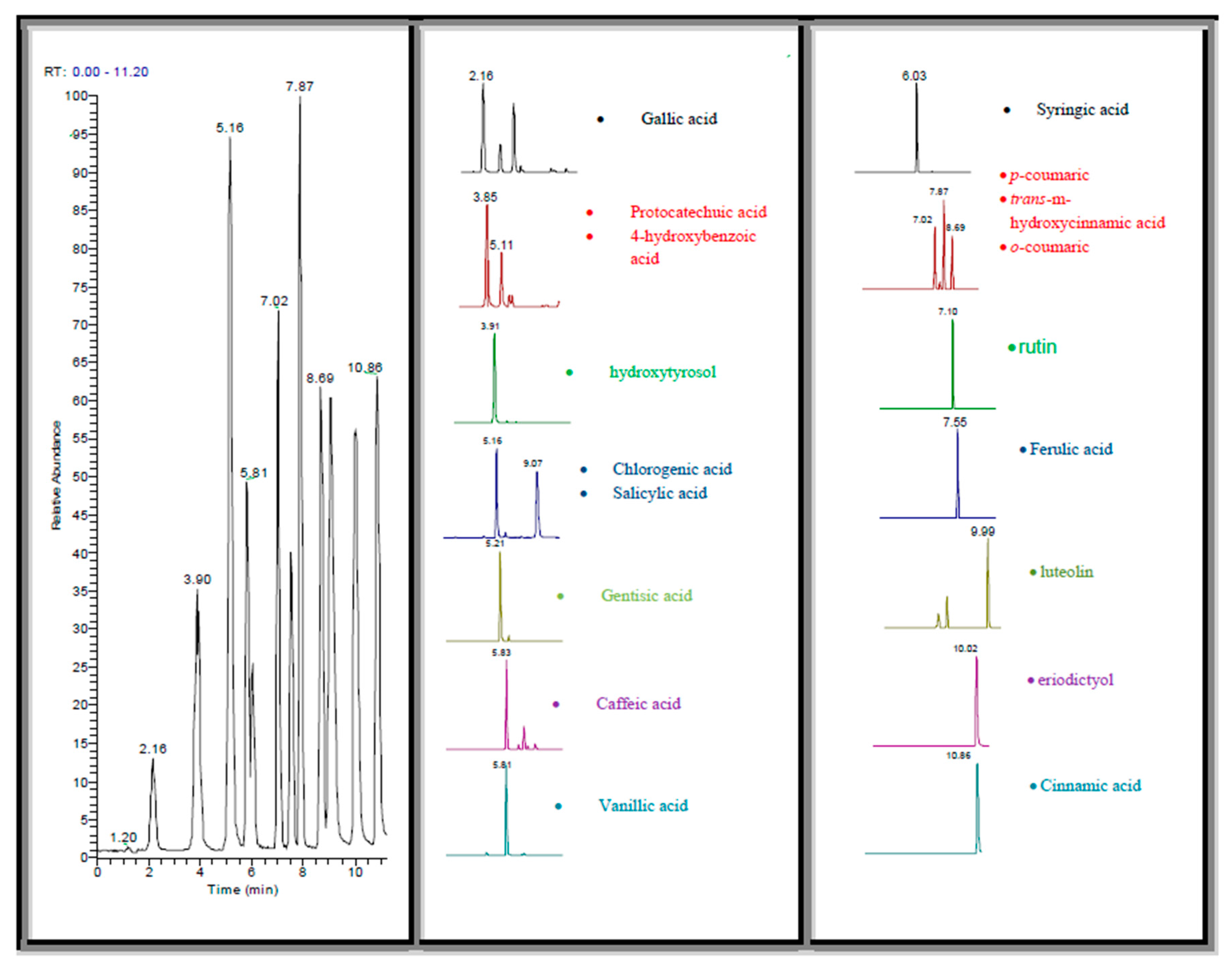Evaluating Modern Techniques for the Extraction and Characterisation of Sunflower (Hellianthus annus L.) Seeds Phenolics
Abstract
:1. Introduction
2. Materials and Methods
2.1. Reagents
2.2. Sunflower Samples
2.3. Preparation of Extracts
2.3.1. UAE, by Water Bath
2.3.2. Microwave-Assisted Extraction (MAE)
2.3.3. TPC Determination
2.4. Determination of Antioxidant Activity (Applied Methods)
2.4.1. 1,1-Diphenyl-2-Picrylhydrazyl (DPPH) Assay
2.4.2. Trolox Equivalent Antioxidant Capacity (TEAC) Assay
2.4.3. Ferric Reducing Ability of Plasma (FRAP) Assay
2.5. LC-MS Analyses
2.5.1. Instrumentation—Analytical Conditions
2.5.2. IStatistics
3. Results and Discussion
3.1. Antioxidant Profile of Sunflower Hulls, Kernels and Press Residue
3.2. Phenolic Profile of Selected Extracts
4. Conclusions
Acknowledgments
Author Contributions
Conflicts of Interest
References
- Thongson, C.; Davidson, P.M.; Mahakarnchanakul, W.; Weiss, J. Antimicrobial activity of ultrasound assisted solvent-extracted spices. Lett. Appl. Microbiol. 2004, 39, 401–406. [Google Scholar] [CrossRef] [PubMed]
- Cowan, M.M. Plant products as anti-microbial agents. Clin. Microbial. Reviews 1999, 12, 564–582. [Google Scholar]
- Salgado, P.R.; Drago, S.R.; Molina Ortiz, S.E.; Petruccelli, S.; Andrich, O.; González, R.J.; Mauri, A.N. Production and characterization of sunflower (Helianthus annuus L.) protein-enriched products obtained at pilot plant scale. Food Sci. Technol. 2012, 45, 65–72. [Google Scholar] [CrossRef]
- Amakura, Y.; Yoshimura, M.; Yamakami, S.; Yoshida, T. Isolation of phenolic constituents and characterization of antioxidant markers from sunflower (Helianthus annuus) seed extract. Phytochem. Lett. 2013, 6, 302–305. [Google Scholar] [CrossRef]
- Pal, D. Sunflower (Helianthus annuus L.) Seeds in health and nutrition. In Nuts and Seeds in Health and Disease Prevention; Preedy, V.R., Watson, R.R., Patel, V.B., Eds.; Academic Press: London, UK, 2011; pp. 1097–1105. ISBN 978-0-12-375688-6. [Google Scholar]
- Salunkhe, D.K.; Chavan, J.K.; Adsule, R.N.; Kadam, S.S. Sunflower. In World Oilseeds: Chemistry, Technology and Utilization; Salunkhe, D.K., Van Nostrand, R., Eds.; Springer Science & Business Media: New York, NY, USA, 1992; pp. 97–139. [Google Scholar]
- Weisz, G.M.; Kammerer, D.R.; Carle, R. Identification and quantification of phenolic compounds from sunflower (Helianthus annuus L.) kernels and shells by HPLC-DAD/ESI-MSn. Food Chem. 2009, 115, 758–765. [Google Scholar] [CrossRef]
- Shah, M.V.; Rohit, M.C. Novel Techniques for Isolation and Extraction of Phyto-Constituents from Herbal Plants. Am. J. Phytomed. Clin. Ther. 2013, 1, 338–350. [Google Scholar]
- Mason, T.J.; Chemat, F.; Vinatoru, M. The extraction of natural products using ultrasound or microwaves. Curr. Org. Chem. 2011, 15, 237–247. [Google Scholar] [CrossRef]
- Proestos, C.; Komaitis, M. Ultrasonically assisted extraction of phenolic compounds from aromatic plants: comparison with conventional extraction technics. J. Food Qual. 2006, 29, 567–582. [Google Scholar] [CrossRef]
- Rodríguez-Rojo, S.; Visentin, A.; Maestri, D.; Cocero, M.J. Assisted extraction of rosemary antioxidants with green solvents. J. Food Engin. 2012, 109, 98–103. [Google Scholar]
- Turner, C. Overview of modern extraction techniques for food and agricultural samples. In Modern Extraction Techniques; ACS Symposium Series: Washington, DC, USA, 2006; Volume 926, pp. 3–19. [Google Scholar]
- Singleton, V.L.; Rossi, J.A. Colorimetry of total phenolics with phosphomolybdicphosphotungstic acid reagents. Am. J. Enol. Vitic. 1965, 16, 144–158. [Google Scholar]
- Proestos, C.; Zoumpoulakis, P.; Sinanoglou, V. Determination of plant bioactive compounds. Antioxidant capacity and antimicrobial screening. Focus. Mod. Food Ind. 2013, 2, 26–35. [Google Scholar]
- Re, R.; Pellegrini, N.; Proteggente, A.; Pannala, A.; Yang, M.; Rice-Evans, C. Antioxidant activity applying an improved ABTS radical cation decolorization assay. Free Radical Biol. Med. 1999, 26, 1231–1237. [Google Scholar] [CrossRef]
- Papandreou, M.A.; Kanakis, C.D.; Polissiou, M.G.; Efthimiopoulos, S.; Cordopatis, P.; Margarity, M.; Lamari, F.N. Inhibitory activity on amyloid-beta aggregation and antioxidant properties of Crocus sativus stigmas extract and its crocin constituents. J. Agric. Food Chem. 2006, 54, 8762–8768. [Google Scholar] [CrossRef] [PubMed]
- Benzie, I.F.; Strain, J.J. The ferric reducing ability of plasma as a measure of “antioxidant power”: The FRAP assay. Anal. Biochem. 1996, 239, 70–76. [Google Scholar] [CrossRef] [PubMed]
- Pedrosa, M.M.; Muzquiz, M.; Garcıa-Vallejo, C.; Burbano, C.; Cuadrado, C.; Ayet, C.; Robredo, L.M. Determination of caffeic and chlorogenic acids and their derivatives in different sunflower seeds. J. Sci. Food Agric. 2000, 80, 459–464. [Google Scholar] [CrossRef]
- Kosinska, A.; Estrella, I.; Hernandez, I.; Duenas, M.; Karamac, M. Antioxidant activity of phenolic compounds identified in sunflower seeds. Eur. Food Res. Technol. 2012, 235, 221–230. [Google Scholar]
- Proestos, C.; Sereli, D.; Komaitis, M. Determination of phenolic compounds in aromatic plants by RP-HPLC and GC-MS. Food Chem. 2006, 95, 44–52. [Google Scholar] [CrossRef]
- Giada, M.D.L.R.; Mancini-Filho, J. Antioxidant capacity of the striped sunflower (Helianthus annuus L.) seed extracts evaluated by three in vitro methods. Int. J. Food Sci. Nutr. 2008, 60, 395–401. [Google Scholar] [CrossRef] [PubMed]
- Szydłowska-Czerniak, A.; Trokowski, K.; Szłyk, E. Optimization of extraction conditions of antioxidants from sunflower shells (Helianthus annuus L.) before and after enzymatic treatment. Ind. Crop Prod. 2011, 33, 123–131. [Google Scholar]




| Lyophilised Samples/Extraction Type | Kernels | Hulls | Press Residue | |||
|---|---|---|---|---|---|---|
| Aq.MeOH | MeOH | Aq.MeOH | MeOH | Aq.MeOH | MeOH | |
| MAE | 160.0 ± 30.0 b,c | 80.7 ± 4.5 a,c | 80.0 ± 15.0 b,c | 35.5 ± 2.5 a,c | 107.4 ± 3.2 a,b | 46.4 ± 3.8 a,b |
| UAE | 325.5 ± 23.2 c | 163.0 ± 19.2 c,† | 165.5 ± 9.1 c | 72.0 ± 11.2 c,† | 215.0 ± 94.3 a,b,† | 93.0 ± 4.2 a,b,† |
| Lyophilised Samples/Extraction Type | Kernels Aq.MeOH Extract a | Kernels MeOH Extract b | Press Residue Aq.MeOH Extract c | |||
| IC50 | AE | IC50 | AE | IC50 | AE | |
| MAE extraction | 38.5 ± 5.0 | 0.030 | 106.6 ± 3.4 | 0.010 | 36.2 ± 1.6 | 0.030 |
| UAE extraction | 9.8 ± 1.1 | 0.121 | 87.6 ± 1.4 | 0.014 | 35.2 ± 1.3 | 0.022 |
| Lyophilised Samples/Extraction Type | Hulls Aq.MeOH Extract a | Hulls MeOH Extract b | Press Residue MeOH Extract c | |||
| IC50 | AE | IC50 | AE | IC50 | AE | |
| MAE extraction | 79.5 ± 0.7 | 0.015 | 123.1 ± 0.9 | 0.010 | 38.8±1.1 | 0.010 |
| UAE extraction | 36.8 ± 1.5 | 0.030 | 126.6 ± 0.8 | 0.010 | 40.5±5.0 | 0.010 |
| Samples/Extraction Type | Aq.MeOH Extract a | MeOH Extract b | |||||||
|---|---|---|---|---|---|---|---|---|---|
| 1 | 10 | 20 | 40 | 1 | 10 | 20 | 40 | ||
| UAE | BHT(*) | 52.5 ± 3.1 | 63.9 ± 2.9 | 72.2 ± 3.1 b,c | 91.2 ± 3.7 b,c | 41.3 ± 2.0 | 52.6 ± 2.5 | 61.3 ± 2.1 a,b | 80.9 ± 2.2 a,b |
| Kernels | 31.6 ± 2.5 b,c | 41.5 ± 1.7 c | 42.7 ± 5.3 b | 50.8 ± 1.0 b | 17.7 ± 4.1a,b | 22.5 ± 6.5 a,b | 22.4 ± 5.4 | 29.3 ± 9.5 | |
| Hulls | 6.4 ± 1.5 b,c | 12.5 ± 2.7 c | 13.5 ± 4.3 b | 21.6 ± 1.1 b | 3.1 ± 0.5 a,b | 6.5 ± 0.8 a,b | 6.6 ± 0.4 | 13.3 ± 1.1 | |
| MAE | BHT(*) | 49.5 ± 3.2 | 61.9 ± 3.2 | 70.2 ± 2.1 b,c | 89.1 ± 3.4 b,c | 38.6 ± 2.5 | 48.9 ± 2.9 | 60.3 ± 1.9 a,b | 78.2 ± 2.6 a,b |
| Kernels | 30.4 ± 2.4 b,c | 40.3 ± 1.8 c | 41.5 ± 4.9 b | 48.8 ± 1.5 b | 16.8 ± 3.9 a,b | 20.5 ± 6.2 a,b | 21.1 ± 4.7 | 28.4 ± 9.1 | |
| Hulls | 5.9 ± 1.5 b,c | 11.9 ± 2.5 c | 12.9 ± 4.1 b | 20.9 ± 1.3 b | 2.8 ± 0.6 a,b | 5.7 ± 0.7 a,b | 5.8 ± 0.5 | 12.7 ± 1.3 | |
| Standards | [M−H]− | RT | Delta (mDa) | |||||
|---|---|---|---|---|---|---|---|---|
| Compound Name | m/z | standards | C | C1 | C2 | C | C1 | C2 |
| gallic acid | 169.014 | 2.16 | 2.16 | 2.11 | 2.17 | 0.1 | 0.2 | 0.1 |
| protocatechuic acid | 153.019 | 3.85 | 3.83 | 3.83 | 3.84 | 0.1 | 0.0 | −0.0 |
| hydroxyTyrosol | 153.056 | 3.91 | 4.14 | −0.0 | ||||
| 4-Hydroxybenzoic acid | 137.024 | 5.11 | 5.02 | 5.04 | 5.03 | −0.1 | −0.1 | −0.1 |
| chlorogenic acid | 353.088 | 5.16 | 5.18 | 5.19 | 5.19 | −1.5 | −1.0 | −1.5 |
| gentisic acid | 153.019 | 5.21 | 5.13 | 5.2 | 0.1 | −0.4 | ||
| caffeic acid | 179.035 | 5.83 | 5.77 | 5.83 | 5.83 | −0.2 | −0.2 | −0.2 |
| vanillic acid | 167.035 | 5.81 | 5.76 | 5.82 | 5.81 | −0.1 | −0.1 | −0.0 |
| syringic acid | 197.046 | 6.03 | 5.95 | 6.02 | 6.03 | −0.8 | −0.5 | −0.2 |
| p-coumaric acid | 163.04 | 7.02 | 6.98 | 7.01 | 7.02 | −0.1 | −0.1 | −0.1 |
| Rutin | 609.146 | 7.10 | 7.08 | 7.1 | −1.4 | −0.5 | ||
| ferulic acid | 193.051 | 7.55 | 7.51 | 7.54 | 7.56 | −0.2 | −0.3 | −0.2 |
| Trans-m-hydroxycinnamic acid | 163.04 | 7.87 | 7.92 | 7.93 | −0.2 | −0.1 | ||
| o-Coumaric acid | 163.04 | 8.69 | 8.65 | −0.2 | ||||
| salicylic acid | 137.024 | 9.07 | 9.07 | 9.12 | 9.19 | 0.1 | −0.1 | 0.0 |
| Luteolin | 285.041 | 9.99 | 9.96 | 9.99 | 10.01 | −0.5 | −0.8 | −0.9 |
| Eriodictyol | 287.056 | 10.02 | 9.95 | 9.99 | 10 | −0.5 | −0.8 | −0.7 |
| cinnamic acid | 147.045 | 10.86 | 10.81 | 10.86 | 10.88 | 0.2 | 0.2 | 0.2 |
© 2017 by the authors. Licensee MDPI, Basel, Switzerland. This article is an open access article distributed under the terms and conditions of the Creative Commons Attribution (CC BY) license (http://creativecommons.org/licenses/by/4.0/).
Share and Cite
Zoumpoulakis, P.; Sinanoglou, V.J.; Siapi, E.; Heropoulos, G.; Proestos, C. Evaluating Modern Techniques for the Extraction and Characterisation of Sunflower (Hellianthus annus L.) Seeds Phenolics. Antioxidants 2017, 6, 46. https://doi.org/10.3390/antiox6030046
Zoumpoulakis P, Sinanoglou VJ, Siapi E, Heropoulos G, Proestos C. Evaluating Modern Techniques for the Extraction and Characterisation of Sunflower (Hellianthus annus L.) Seeds Phenolics. Antioxidants. 2017; 6(3):46. https://doi.org/10.3390/antiox6030046
Chicago/Turabian StyleZoumpoulakis, Panagiotis, Vassilia J. Sinanoglou, Eleni Siapi, George Heropoulos, and Charalampos Proestos. 2017. "Evaluating Modern Techniques for the Extraction and Characterisation of Sunflower (Hellianthus annus L.) Seeds Phenolics" Antioxidants 6, no. 3: 46. https://doi.org/10.3390/antiox6030046






